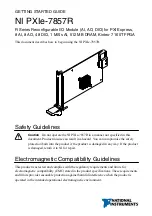
8.5 Basics - IP address and subnet
Exclusively IPv4 is supported. At IPv4 the IP address is a 32bit address that must be
unique within the network and consists of 4 numbers that are separated by a dot. Every
IP address is a combination of a
Net-ID
and a
Host-ID
and has the following
Structure:
xxx.xxx.xxx.xxx
Range: 000.000.000.000 to 255.255.255.255
The
Net
work-ID identifies a network res. a network controller that administrates the net-
work. The Host-ID marks the network connections of a participant (host) to this network.
The Host-ID can be further divided into a
Subnet-ID
and a new
Host-ID
by using a bit for
bit AND assignment with the Subnet mask.
The area of the original Host-ID that is overwritten by 1 of the Subnet mask becomes the
Subnet-ID, the rest is the new Host-ID.
Subnet mask
binary all "1"
binary all "0"
IPv4 address
Net-ID
Host-ID
Subnet mask and IPv4 address
Net-ID
Subnet-ID
new Host-ID
At the first start-up of the CPU, the Ethernet PG/OP channel and the PROFINET IO con-
troller do not have an IP address.
Information about the assignment of IP address data to the Ethernet PG/OP channel may
Chap. 5.6 ‘Hardware configuration - Ethernet PG/OP channel’ page 42
Information about the assignment of IP address data to the EtherCAT connection may be
found in
‘Assign IP address parameters’ page 126
For IPv4 addresses there are five address formats (class A to class E) that are all of a
length of 4byte = 32bit.
Class A
0
Network-ID (1+7bit)
Host-ID (24bit)
Class B
10
Network-ID (2+14bit)
Host-ID (16bit)
Class C
110
Network-ID (3+21bit)
Host-ID (8bit)
Class D
1110
Multicast group
Class E
11110
Reserved
The classes A, B and C are used for individual addresses, class D for multicast
addresses and class E is reserved for special purposes. The address formats of the 3
classes A, B, C are only differing in the length of Network-ID and Host-ID.
These addresses can be used as net-ID by several organizations without causing con-
flicts, for these IP addresses are neither assigned in the Internet nor are routed in the
Internet. To build up private IP-Networks within the Internet, RFC1597/1918 reserves the
following address areas:
IP address structure
Net-ID, Host-ID
Subnet mask
Address at first start-up
Address classes
Private IP networks
System 300S
+
Deployment Ethernet communication - productive
Basics - IP address and subnet
HB140 | CPU | 315-4PN23 | en | 18-02
106
















































